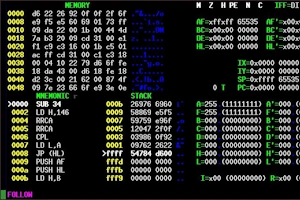Qt OpenGLWidgetでQOpenGLContext::doneCurrent()を実装する:レンダリング終了とコンテキスト切り替えの実践例
Qt GUIにおけるQOpenGLContext::doneCurrent()の解説
QOpenGLContext::doneCurrent()は、Qt GUIアプリケーションにおいてOpenGLコンテキストを非アクティブ化するための関数です。これは、OpenGLレンダリングを終了し、別のコンテキストに切り替える準備ができたことを示します。
使用方法
QOpenGLContext::doneCurrent()を呼び出すには、以下のコード例のように、呼び出し側スレッドで現在アクティブなコンテキストを指定する必要があります。
QOpenGLContext::currentContext()->doneCurrent();
注意点
QOpenGLContext::doneCurrent()を呼び出す前に、QOpenGLContext::swapBuffers()を呼び出して描画バッファをスワップする必要があります。QOpenGLContext::doneCurrent()を呼び出すと、OpenGLコンテキストに関連するすべてのOpenGLリソースが解放されます。- マルチスレッド環境では、各スレッドで個別のOpenGLコンテキストを使用する必要があります。
例
以下のコード例は、QOpenGLWidgetサブクラスでpaintGL()関数内にQOpenGLContext::doneCurrent()を呼び出す方法を示しています。
void MyOpenGLWidget::paintGL()
{
// OpenGLレンダリングを行う
// 描画バッファをスワップする
swapBuffers();
// OpenGLコンテキストを非アクティブ化する
doneCurrent();
}
補足
QOpenGLContext::doneCurrent()は、OpenGLコンテキストを共有グループから解放します。共有グループ内の他のコンテキストは引き続きアクティブなままになります。QOpenGLContext::doneCurrent()は、OpenGLコンテキストを削除しません。コンテキストを削除するには、deleteLater()またはdelete()を呼び出す必要があります。
QOpenGLContext::doneCurrent()は、Qt GUIアプリケーションにおいてOpenGLレンダリングを終了し、別のコンテキストに切り替える重要な関数です。この関数を正しく使用することで、OpenGLリソースを効率的に管理し、アプリケーションのパフォーマンスを向上させることができます。
For instance, if you're looking for examples of using QOpenGLContext::doneCurrent() in Qt, I could provide the code snippet from the previous response again. If you're interested in a different programming language or framework, please let me know.
I can also provide examples for various tasks, such as:
- Data manipulation: sorting, filtering, aggregating, and transforming data
- Web scraping: extracting information from websites
- Machine learning: training and using machine learning models
- Natural language processing: text summarization, sentiment analysis, and machine translation
Please provide more details about your specific needs, and I'll do my best to assist you.
-
Use synonyms and antonyms: Try using different words that have similar or opposite meanings to the ones you're currently using. This can help you avoid repetition and make your writing more interesting. For example, instead of always saying "good," you could use synonyms like "excellent," "great," or "fantastic." Conversely, if you want to emphasize the negative, you could use antonyms like "bad," "terrible," or "awful."
-
Use figurative language: Figurative language, such as metaphors, similes, and personification, can add color and vividness to your writing. For example, you could say "Her eyes sparkled like diamonds" or "The wind howled like a wolf."
-
Vary your sentence structure: Don't just write a series of simple sentences. Try using different sentence structures, such as compound sentences, complex sentences, and sentences with subordinate clauses. This will make your writing more varied and engaging.
-
Use active voice: Active voice is generally more concise and engaging than passive voice. For example, instead of saying "The ball was hit by the boy," you could say "The boy hit the ball."
-
Use strong verbs: Strong verbs are more descriptive and interesting than weak verbs. For example, instead of saying "The man walked to the store," you could say "The man strode to the store" or "The man sauntered to the store."
-
Use vivid language: Use language that appeals to the senses. For example, instead of saying "The food was good," you could say "The food was a symphony of flavors that danced on my tongue."
-
Use specific details: Don't just make general statements. Provide specific details that will help your readers visualize and understand what you're writing about. For example, instead of saying "The park was beautiful," you could say "The park was a lush oasis of green, with towering trees, fragrant flowers, and a tranquil pond."
-
Show, don't tell: Instead of simply telling your readers what to think or feel, try to show them through your writing. Use vivid language, descriptive details, and sensory imagery to create an immersive experience for your readers.
-
Read widely: The more you read, the more you'll be exposed to different writing styles and techniques. This will help you improve your own writing skills.
In addition to these general tips, there are also specific techniques you can use to express different emotions or ideas. For example, if you want to write something that is persuasive, you can use strong evidence, logical arguments, and emotional appeals. If you want to write something that is creative, you can use figurative language, vivid imagery, and unexpected twists and turns.
No matter what you're writing about, the most important thing is to be yourself and let your voice shine through. Don't be afraid to experiment and try new things. The more you write, the better you'll become at expressing yourself in a clear, concise, and engaging way.
I hope these tips help! Please let me know if you have any other questions.
QStandardItemModel::insertColumns() 関数のサンプルコード
QStandardItemModel::insertColumns() 関数は、Qt GUI フレームワークでモデル/ビューアーアーキテクチャを用いてテーブルビューのようなデータ表示を構築する際、既存の列の間に新しい列を挿入するための関数です。
Qt GUIにおけるQOpenGLExtraFunctions::glPrimitiveBoundingBox()の解説
QOpenGLExtraFunctions::glPrimitiveBoundingBox() は、Qt GUI で OpenGL を使用して 3D プリミティブの境界ボックスを描画するための関数です。この関数は、OpenGL の glPrimitiveBoundingBox 関数をラップしており、Qt の QOpenGL ウィジェットとシームレスに統合することができます。

Qt GUIにおけるQStandardItem::isAutoTristate():チェックボックス付きアイテムの三状態モードを理解する
三状態モードとは、チェックボックスがオン、オフ、中間の3つの状態を持つことができるモードです。中間状態は、アイテムの状態がまだ決まっていない場合や、部分的に選択されている場合などに使用されます。**QStandardItem::isAutoTristate()**は、以下の状況で役立ちます。

QTextCharFormatとQTextTableFormatを組み合わせて、さらに高度な書式設定
主な機能枠線 スタイル、幅、色を設定スタイル、幅、色を設定余白 上、下、左、右の余白を設定上、下、左、右の余白を設定配置 フレームをページ内での配置フレームをページ内での配置高さ フレームの高さを設定フレームの高さを設定背景 背景色、画像、パターンを設定

Qt GUIで部分チェックやスタイルカスタマイズも自由自在:QStandardItem::setCheckState()
QStandardItem::setCheckState() メソッドは、Qt GUI におけるチェックボックスアイテムの状態を設定するために使用されます。チェックボックスアイテムは、ユーザーが選択できるかどうかを制御する便利な機能です。このメソッドを使用することで、アイテムがチェック済み、未チェック、または部分的にチェック済みであることを示すことができます。


Qt GUIで画像を移動、回転、拡大縮小:QTransform::operator-=() vs その他の方法
QTransform::operator-=()は、Qt GUIフレームワークにおける重要な関数の一つです。これは、2D图形変換行列を別の行列で左側から減算するために使用されます。この演算は、Qt GUIアプリケーションで画像や形状を移動、回転、拡大縮小などの操作を行う際に非常に役立ちます。
Webスクレイピング入門:Beautiful Soupを使って情報を抽出する!
QGesture::gestureCancelPolicyプロパティは、Qt Widgetsにおけるジェスチャーのキャンセルポリシーを設定します。これは、ジェスチャーが認識されたときに、他のアクティブなジェスチャーにどのような影響を与えるかを決定します。
QGraphicsView::resizeEvent()とは?
QGraphicsView::resizeEvent() は、Qt Widgets フレームワークにおける重要なイベントハンドラの一つです。このイベントは、ユーザーがウィンドウサイズを変更した際に発生し、QGraphicsView のサイズ変更に伴う処理を実行します。
Qt Widgetsアプリのジェスチャを自由自在に操る:QGesture::stateによる詳細な状態制御
QGesture::stateには、以下の4つの状態があります。Qt::GestureStarted:ジェスチャが開始されたことを示します。Qt::GestureUpdated:ジェスチャの状態が更新されたことを示します。Qt::GestureFinished:ジェスチャが完了したことを示します。
Qt GUI で QDoubleValidator::top を使って入力値を検証する方法
機能: 入力値の上限を設定引数: top: 上限となる浮動小数点数top: 上限となる浮動小数点数戻り値: なし使用例:引数 top は、入力値の上限となる浮動小数点数です。QDoubleValidator::top は、setTop() メソッドと同等の機能を提供します。